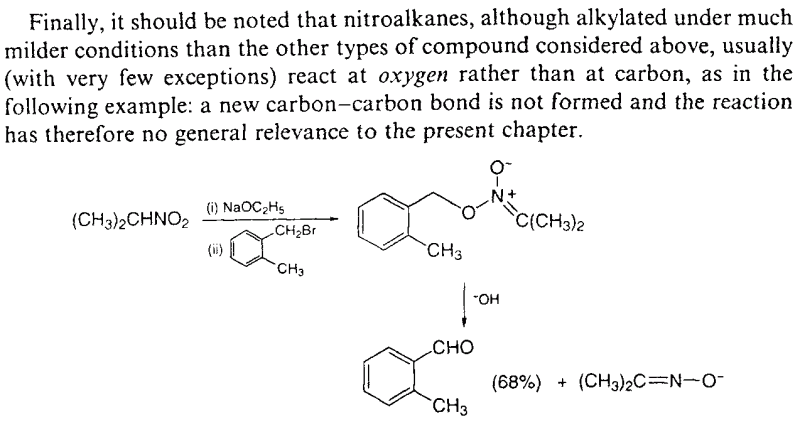Originally posted by tupence_hapeny
Here is a reduction of the phenylalaninal to phenylalaninol using only baker's yeast:
Here is the relevant section (experimental) of the article:
| Quote: | 4.1. General procedure for bioreduction of α-substituted-cinnamaldehydes
Respective �-substituted-cinnamaldehyde (4.7 mmol) dissolved d in 1.5 ml of ethanol was added to a mixture of 25 g dry baker’s yeast (Emulzint®)
and 10.4 g of glucose in 250 ml of water at 30 ◦C and pH = 5.5 (the pH of the fermenting yeast mixture was adjusted to 5.5 by the addition of
saturated sodium carbonate solution). The resulting suspension was stirred in an orbital shaker (200 rpm) at 30 ◦C until full conversion (48 h).
The product was extracted with CH2Cl2 and purified by column chromatography using hexane/ethyl acetate (7:3).
4.2. 2-Azido-3-phenyl-2-propenal (5)
To a stirred slurry of 1.2 g (18.5 mmol) of sodium azide in 20 ml of acetonitrile cooled methanol-dry ice bath, 3.0 g (18.5 mmol) of iodine
monochloride in 10 ml of acetonitrile was slowly added over a period of 10 min. The reaction mixture was stirred for an additional 10 min. followed by
addition of 2.3 g (18.2 mmol) of the cinnamaldehyde, and then allowed to warm to room temperature and stirred for 6 h.
The red-brown slurry was poured into 100 ml of water, the adduct was extracted with 200 ml of ether and washed with 300 ml of 5% sodium thiosulfate
aqueous solution in three portions leaving a colourless solution. The organic phase was dried on MgSO4. Evaporation of the solvent furnished crude
azide adduct (slightly orange) and used in the preparation of 5.
A solution of 5.0 g (16.6 mmol) of azide adduct (3-azido-2-iodo-3-phenylpropanal) and 4.0 g (61.5 mmol) of sodium azide in 30 ml of DMF (dried over
molecular sieves, type 4A) was stirred for 1 h at room temperature. The solution was then poured into a mixture of water–ether, and the ether layer
was washed with water and dried (MgSO4). Evaporation of the solvent furnished crude aldehyde 5.
Purification was achieved by flash column chromatography using hexane/ethyl acetate (7:3), affording 5, a yellow crystalline solid, mp 73–74
◦C, 96% yield...
4.3. (S)-2-Azido-3-phenyl-1-propanol ((S)-6)
When 0.8 g (4.7 mmol) of 2-azido-3-phenylpropenal 5 was subjected to the general procedure for bioreduction, the isolated product was (S)-6 (0.8 g,
97.7%) as a yellow oil...
4.4. 2-Bromo-3-phenyl-2-propenal (7)
A solution of 5.0 g (37.88 mmol) of cinnamaldehyde in 15 ml of CCl4 was cooled to 0 ◦C and treated dropwise with 6.1 g (38.1 mmol) of bromine in
5ml of CCl4. The mixture was stirred vigorously during 1 h, washed with a aqueous solution of sodium bisulfite and the organic phase was dried on
MgSO4. Evaporation of the solvent furnished crude aldehyde 7.
Purification was achieved by flash column chromatography using hexane/ethyl acetate (7:3), affording 7, a yellow crystalline solid, mp 72 ◦C,
87.6% yield...
4.5. (S)-2-Bromo-3-phenyl-1-propanol (S)-8
When 1.0 g (4.7 mmol) of 2-bromo-3-phenyl-2-propenal 7 was subjected to the general procedure for bioreduction, the isolated product was (S)-8 (1.0 g,
98.1%) as a yellow oil... |
I have as yet been unable to upload the article, so the details above are provided in an abridged format (without the calculated/found's).
The article itself is:
L.C. Fardelone et al, 'Baker’s yeast mediated asymmetric reduction of cinnamaldehyde derivatives' Journal of Molecular Catalysis B: Enzymatic 29
(2004) 41–45
The direct bromination of cinnamaldehyde and subsequent bio-reduction of the same offers some promise - however, what caught my eye is the idea that a
protected (benzyl/phthaloyl/etc) phenylalanine (or variant upon the same theme) could be reduced via yeast to the alcohol. Deprotection via reduction
(would HI work with Benzyl?) which may also affect reduction of the amino alcohol to amphetamine.
Thoughts would be good...
BTW, what methods could be used to reduce amino esters to amino aldehydes apart from the sodium amalgam?
[Edited on 16-5-2007 by tupence_hapeny] |




